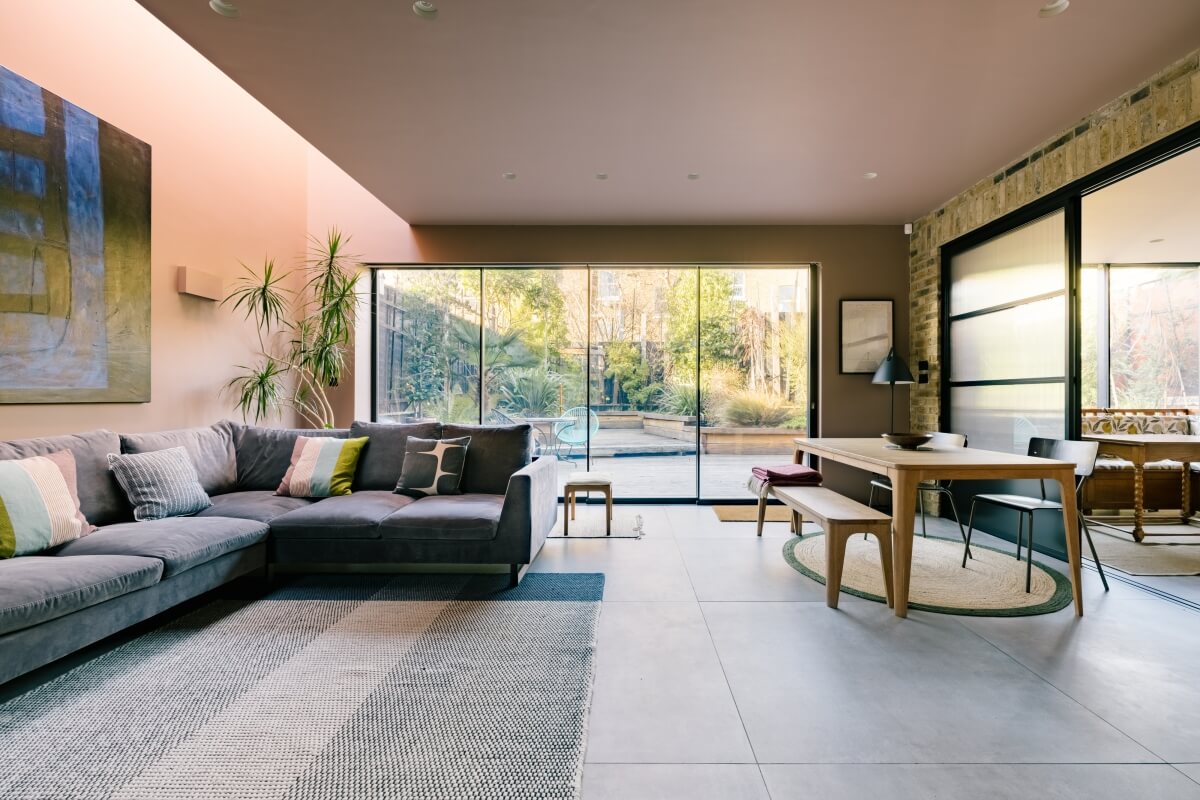Georgia Lowe
An interview with theatre designer Georgia Lowe.
January, 2022








We visit Theatre Designer Georgia Lowe in her self-built contemporary home. Combining her talent for design and her partners' fabrication skills, Georgia talks us through how their creative career journey has inspired the architectural and furnishing choices of their live/work home. From rooflights instead of windows, deep colours and a lot of art, an innate element of drama cascades throughout; from the bedroom, to Georgia's studio. If anywhere’s an inspiring space, it’s this one.
Could you tell us a little about yourself and how you came to be involved in theatre set and costume design?
I studied Drama at university, with a view to performing. Yet, as the course progressed, I instinctively got more interested in space, design and the visual aspects. I was still performing, but mainly for pieces I had written or created myself. Even then, there'd be an emphasis on design. After graduating, I tried various things - fashion styling, working in PR and photography. But it was whilst waitressing, that I ended up being offered my first design job working in fringe theatre venues. I immediately fell in love with it and have been doing it ever since. I went back to train for a year in Theatre Design on an inspiring course called Motley, which was based in the back of Drury Lane Theatre, then landed a job as a design assistant at the RSC which proved a great stepping stone to bigger jobs .

With your parents both being artists, your dad a sculptor and mother a painter and ceramicist, do you think your background influenced your journey into design?
Yes, totally. I grew up surrounded by art and my Viennese grandparents were theatre and opera fanatics. So I was taken to see art and performance from a very young age. You could say both have played a huge part in my life.

Since turning freelance and working from home, what does your role entail? What are your day-to-day focuses?
No day is ever the same. Which sometimes makes it a little tricky to schedule or plan ahead, but is also why I love being freelance.
I am usually working on at least two productions at once; it’s challenging juggling between shows that are often at different stages. Our home is live/work, and I spend most of my day in the studio. I make pinterest mood/vision boards to inspire design, sketch/draw plans and model up ideas. I also hold my meetings here with directors or other creatives. Having a live/work space is useful because if I do need to work an extra couple of hours on an evening, I can. It works better this way as I am less restricted. The downside is, I can sometimes get distracted by the washing machine or dishwasher! I often have to be strict and shut myself off to focus.

How do you go about designing for a particular show and venue?
If it’s a play, I always start by reading it a number of times. It’s important for me to get my head into the text before beginning to properly visualise anything. Although, this process sometimes happens instinctively whilst reading. Then, there are alot of meetings with director(s) and the rest of the creative team to discuss any initial concept ideas. This collaborative process of talking through staging, lighting, sound and movement is crucial as it informs the rest of the designs.
I am given a modelbox of the space, this is a 1:25 scale replica of the theatre stage. Within this, I make lots of sketch models using white card until I find something that feels right. I then go through a process of refining and trialling before presenting the final design to all heads of department. Any costs or practicalities are discussed here - there are often a number of compromises to make. I do find however, this stage really focuses my attention to what the most crucial and/or interesting elements are. Following this initial design process, my time is split between set building workshops, prop meetings, costume fittings and spending time in rehearsals. This is my favourite part - it’s where everything comes alive!

How does your night's sleep affect your work-day ahead?
If I wake up feeling refreshed, I feel more inspired. Sleep, in many ways, affects how many ideas I can generate;. it’s harder for me to get my brain into a creative place when I’m exhausted. Since my job entails a huge amount of inspiration gathering and idea generation, it’s important for me to get at least 6 hours of sleep.
In working with material and texture in your designs, what do you look for when choosing fabrics?
This is an interesting question, as it hugely depends on the project. For instance, I designed a panto last Christmas at the National Theatre which was all about exuberant textures, popping colours and making people laugh. The materials were gaudy and bold, with each costume taking on it’s own identity. I made one that was completely in pink, with different textures and tones. Another was a dress, constructed entirely of textile-made fried eggs. Different projects may require period detail or choosing textures related to who the character is. This is really about what statement we want to make.

Does your work take on a particular style, and how has this developed?
I’m definitely drawn to expressionism over naturalism. This developed quite instinctively from even before I started working in theatre - it was what I loved watching. For example, if I have a play that is set in a kitchen or other domestic space, I would be more interested in finding what the expressionistic world of that is. I favour bold visual elements that allow actors the freedom to play. It’s important to me that my work sparks exploration in rehearsals and so creating a ‘playground’ of sorts always feels exciting.
My taste veers towards minimalism, in that objects are tools for storytelling rather than pieces of ‘decoration’. The journey that the space, objects and actors go on and how this progresses is what interests me.

How has this career journey and talent for design inspired your space, at home?
It had always been a dream of mine to build my own house. Designing for performance requires a similar way of working - the models I make are very similar to architectural ones. My partner is a carpenter and so he too shared this dream. With his skill set and my design eye, it not only made sense but would also be the most affordable way to have a house that we could also work in.
We were very involved in the design and collaborated closely with our architect Christina Brandenburg. I had Pinterest boards and a model for every room and would visit each day to discuss/think through ideas. When I begin designing, I am always interested in the theatre building/auditorium. How an audience views the performance is one of the most important considerations. Equally, I thought a lot about how the house would be perceived when you step inside and walk around. How could I create the most interesting and surprising angles and views throughout?
The land we bought included a 19th century stable building which was in very bad disrepair. We took it down, but cleaned and used all of its original bricks. It’s amazing to have the central brick wall running through the house that has so much history alongside other contemporary elements.
When working in my studio, I find myself inspired by the space we have created. I will often be doing a sketch model and realise that the shape of something is the same as an element from within the house or garden.
Is your design style reflected in your home edit?
The space is minimal in one sense, but there is also a lot of art and colour. I love using bold colors in my designs; if I don’t use them in the set then I’d use them in the costumes. This is reflected through the artworks I have on the walls, which were mostly painted by my mum - Biddy Bunzl. I also tend to think very sculpturally, which can be seen through the dramatic high ceilings and the angles at which light enters the room. There is a definite drama to the house.
Given the beautiful pieces in your home, can you recommend any hidden shops or places you go-to to find furniture or home accessories?
I like to mix new and old. My mid-century modern cupboards, for instance, were my grandmothers. They were coated in a shiny lacquer that we didn't like too much. Toby (my partner) sanded them down and now they fit with the rest of our aesthetic. All the wood in the studio is recycled from exhibitions Toby has worked on too. Then, my lamp is from La Redoute and my sofas are from Love Your Home. All mixed in with a fair bit of IKEA of course!
I like various scandi shops - Nordic Nest is one. I’ve also tried to buy locally; there are more and more homeware shops (new and old) popping up around the area. One of my favourites is Simple Shape, which has beautiful UK designed/made products. It’s great to support independent shops in the area and get to know the people that run them.
Deep dive into your bedroom. How do you like your space to feel and how did you choose some of the key elements?
Our bedroom has very high ceilings. Initially I was unsure about this, since I love a bedroom to feel cosy. But it was about balancing this to create a room that didn't feel too cold or stark. Choosing deeper colours and bold artwork helps to draw in the space. It’s rare to have privacy or feel isolated in London, so by opting for rooflights instead of windows too means we get this sense of tranquility. We don’t have a door on the ensuite bathroom, which I like as we can see through to the patterned tiles on the floor. There’s something about seeing aspects of the house from one viewpoint that really adds movement and fluidity.
Do you favour premium materials at home? How important is the quality and design of your bedding?
My bedding is super important. I love to sleep, but with two young kids, it hasn't quite been what it used to be. In a way, this makes the choice of my bedding even more essential. I love either a soft washed cotton or linen in strong, deep colours. Akin to the feel of my bedroom, I find the solitude of navy or dark green is comforting.
